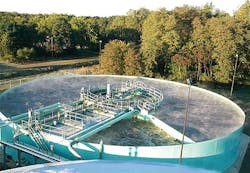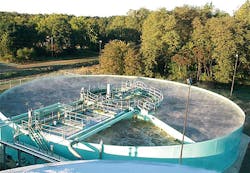Space-Efficient Treatment System Polishes Beverage Waste Streams to Strict Effluent Levels
By Don Aholt
When a Fortune 500 fruit juice producer sought to meet stringent permit levels for its wastewater discharge at its Michigan processing facility, the company’s engineering team specified a high-rate biological treatment system as a part of a comprehensive treatment scheme. The permitting called for stringent effluent requirements on the plant’s 0.5-million-gallon-per-day (MGD), high-strength waste stream: 4 mg/L biochemical oxygen demand (BOD), 5 mg/L total suspended solids (TSS), 0.5 mg/L ammonia, 0.5 mg/L phosphorus, and 6 mg/L dissolved oxygen (DO). The flow characteristics entering the system are typically around 650 mg/L BOD, 500 mg/L TSS, 70 mg/L total Kjehldahl nitrogen (TKN) and phosphorus varying from 7 to 20 mg/L.
In order to help meet these requirements, Smith & Loveless designed a custom biological treatment system which serves as an aerobic polishing step to an anaerobic reactor. The design incorporates single-stage aeration, integrated clarification, post-aeration, nitrification, sludge holding, a selector zone, tertiary filtration, and phosphorus precipitation - all in one circular tank with a diameter of 124 feet.
To prevent filamentous bacteria, the flow enters through a selector zone, which mixes with RAS solids in an anoxic environment to yield short periods of low DO. Next, the aeration zone includes state-of-the-art air diffusion equipment for efficient oxygen transfer, effective mixing and minimal energy usage. The diffuser grids can be adjusted within the aeration zone to optimize treatment. The zone also contains integral instrumentation for process monitoring of pH, DO, mixed liquor suspended solids (MLSS), and temperature levels, which allows the system’s operator to easily control the plant from a remote operations room or on the plant bridge.
Following aeration, the flow enters a specially-designed flocculating clarifier, which includes a 7,000 gallon floc zone to improve distribution of the flow in the settling zone of the clarifier. The effluent from the clarifier encounters an integral dual-media filter for further reduction of BOD and TSS. The filter also aids in reducing the TKN associated with the effluent biological solids. A post-aeration zone raises the DO level to provide effluent level of 6 mg/L. Chemical feed precipitates phosphorus while supplying alkalinity as necessary to maintain the pH level. A sludge storage zone (capacity of 115,000 gallons) sufficiently handles sludge generated during BOD removal for about seven days with a concentration of 2 percent.
Space efficiency in its footprint is another key feature of the design, preserving precious facility land for other plant operations. Circular steel tankage is also the most durable package design for retaining large volumes of wastewater while minimizing the use of steel raw material cost. In colder climates like Michigan, the all-encompassing tankage minimizes the surface area exposure to the elements, which saves heat and protects the biological operation. Additionally, the design eliminates external pipes, pumps, and service walkways. This helped keep the overall project under budget.
Don Aholt, M.S., is the vice president of the Industrial Division of Smith & Loveless Inc., a global leader in the engineering and manufacturing of packaged wastewater treatment and pumping systems. He can be reached at [email protected].

